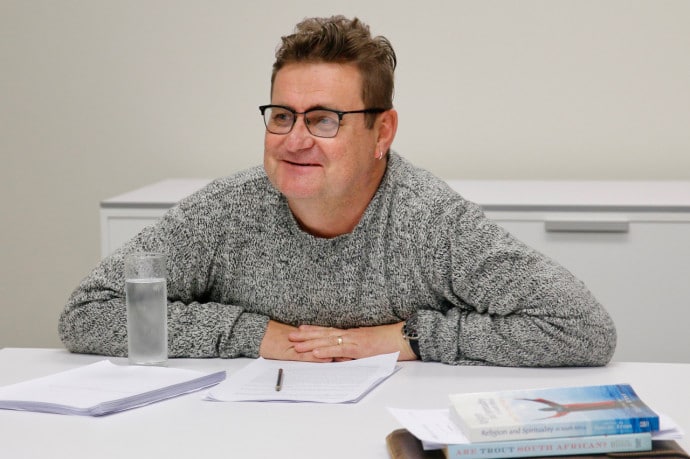“If we don’t have the words we can’t speak about certain things,” said Duncan Brown, Dean of the Faculty of Arts at the University of the Western Cape and STIAS fellow. Brown is at STIAS to finalise his latest book entitled Wilder Lives: Humans and our Environments.

The book is concerned with debates about ‘wildness’ and ‘rewilding’, and explores the question of whether we can find ways of rethinking ‘wildness’ which are more enabling in understanding the complexities of human interactions with, and responsibilities towards, the biological systems and processes on which life depends. It will cover issues such as wildness and conservation, wildness and local language, wild seams and margins, wild cities, the wild and the farmed, wild fish, and wild ethics. For the presentation Brown focused largely on the chapter on language.
“This chapter is concerned with the possibilities of language, specifically local languages, or languages of locality, in this regard.” he said. “Human language is probably the largest, most complex, diverse and contested subject that anyone can engage with. I hope to explore some examples of interesting engagements of (mostly) local languages with the wilding or dewilding of their environments.”
“Rewilding involves expanding our ability to read the signs of the systems and life forms around us: wind, clouds, rain, tracks, waterways, nests, droppings, waves, currents, movements, behaviours, colouration, texture, shape, and myriad identifiers or differentiators,” he continued. “There is an enormous body of knowledge from which to draw, and the languages to capture it, should we choose to find them.”
Brown explained that it is about the human in relation to the environment and the expectation that we are able to read the signs of the world and describe them. “Seeking ways to apprehend the environment is fundamental to categorising the world we live in,” he said. “We need a richer, more nuanced vocabulary.”
Brown focused on some examples including Scottish Gaelic, Afrikaans and Xhosa.
“The Scots have many words to describe the multiple manifestations of Scottish weather, particularly rain,” he said. “They are daunting for non Scots. It’s about the ability of a single world to capture a feature of landscape that might require a whole paragraph in another language.”
Similarly he pointed to words from Afrikaans – like kloof, bult, hoek, nek, vlei – some of which he described as virtually untranslatable and which have become part of global English.
“Afrikaans provides a rich resource of terms for the landscape,” he said. “They provide a precise description that is evocative and delightful.”
“Dictionary definitions seek English equivalents but the idiomatic fullness is often lost, leaving us with clumsy and inadequate language. We need more expansive definitions.”
He pointed to Afrikaans as having a unique, in-between niche status as both a language of colonisation and of the grassroots.
Brown made it clear though that in a time when dictionaries are deleting words because they are no longer used, the chapter is not about advocating antiquated speech but about alerting us to the fact that we are increasingly making do with impoverished language. “The loss of terms means we are losing the ability to read environmental and biological signs – especially where these are changing due to climate change and other environmental degradation. There is an urgency. We need a new vocabulary to describe the changes.”
“People who lived in nature had a lexicon of terms based on reading the environment. With colonialism people were dewilded, not just language, and became estranged in their own world.”
“Indigenous languages are rooted in place and evolved in conjunction with the landscape. We still have little cognition of the range of practices embedded in these languages.”
“Colonial authorities were ruthlessly aggressive in asserting control of language,” he continued. “English as a common language means a specific understanding of landscape along European lines. What it cannot name it suppresses as ‘wildness’.”
“Words like ‘nature’ or ‘wildness’ are not in many African languages.”
“Even the selective appropriation of indigenous words was power related,” he added.
Thinking and dwelling differently
Brown believes this project is important for conservation, social justice and the preservation of indigenous and ecological knowledge.
“It’s not about romanticising the natural world,” he said. “It’s making a conscious choice and commitment to a different sort of engagement. Learning how to think and dwell differently. Rewilding is about rethinking human relationships with the environment.”
And part of this is about shaking up language – learning and re-learning. “I don’t believe we have a true sense of what is happening in the environment,” he said. “We need more complex language to register the changes. It’s about understanding the biological processes and some of this may involve recovering concepts and terminology from local languages.”
Brown also pointed to the need for more archiving projects. “Knowledge is dying off along with the words,” he said. “It’s about a body of knowledge and the language to capture it.”
“I hope the book will be about enriching the ways in which we engage with what is around us, how we think about it and how we value it. You preserve only what you value,” he concluded.
Michelle Galloway: Part-time media officer at STIAS
Photograph: Christoff Pauw
